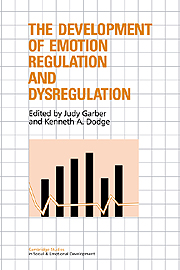13 - Emotions system functioning and emotion regulation
Published online by Cambridge University Press: 26 March 2010
Summary
Three objectives guided the writing of this chapter. The first was to provide a sample of differences among emotion theories that need to be considered in research on emotion regulation. The second was to delineate a broad conceptual framework for understanding and investigating emotion-regulatory mechanisms and processes. The third was to show how the contributions to this volume relate to our proposed theoretical framework.
Conceptions of emotion, emotions system functioning, and emotion regulation
There are numerous definitions and theories of emotion. Some of the differences among them have important implications for the way that the functions of emotions are conceived and investigated. The same holds for the concept of emotion regulation; that is, a clear statement of one's view of the nature and functions of emotions should guide theories of and research on emotion regulation.
Definitions of emotions
Emotion has been defined as an interrelated set of processes at the neural, expressive, and conscious-experiential levels (Izard, 1971; Izard & Tomkins, 1966). The neural aspect involves central structures (e.g., thalamoamygdala pathway), hormones, and neurotransmitters; expression includes facial, vocal, postural, and gestural activities; and the conscious-experiential aspect consists of emotion-feeling states. Autonomic nervous system (ANS) activities are seen as secondary expressive behaviors that follow from somatic expression (striated-muscle activity) and emotion feeling. We view these component processes as constituting an emotion system. The several discrete emotion systems
- Type
- Chapter
- Information
- The Development of Emotion Regulation and Dysregulation , pp. 303 - 322Publisher: Cambridge University PressPrint publication year: 1991
- 30
- Cited by



